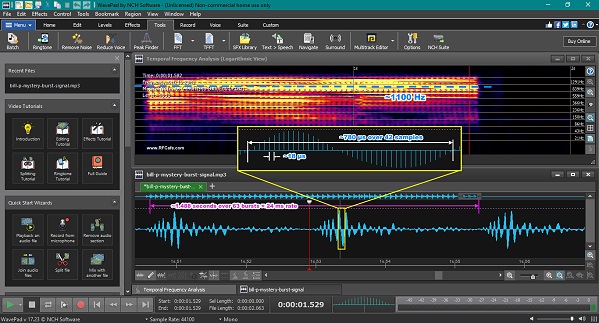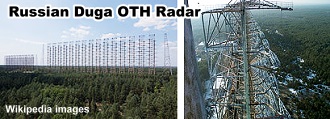Mystery Burst Transmission in the HF Ham Bands
|
|
1 | 2 | 3 | 4 | 5 | 6 | 7 | 8 | 9 | 10 | 11 | 12 | 13 | 14 | 15 | 16 | 17 | 18 | 19 | 20 | 21 | 22 | 23 | 24 | 25 | 26 | 27 | 28 | 29 | 30 | 31 | 32 | 33 | 34 | 35 | 36 | 37 From Bill P. on 2/21/2023: I was just thinking about these Mystery Bursts in the HF ham bands and thought I would speculate what they are: Could they be QPSK modulation on a nearby Digital TV broadcasting station (or far away considering the author is in the mountain area) which is around 9 to 10 MHz switching frequency, and the mystery bursts are the 3rd harmonic content of the fundamental Digital QPSK modulation frequency times 3 (9 MHz x 3) = in the CB radio band of 27 MHz.
A couple days ago, website visitor Bill P. wrote from his location in the western mountains of North Carolina to ask whether I have any information on a mysterious transmission he has been picking up in the 10− and 12−meter bands (28.000 to 29.700 MHz and 24.920 to 24.930 MHz, respectively) that "only appears when the bands are open." The signal has appeared intermittently for more than ten years. He included a link to a demodulated audio file of the captured signal. It sounds like a series of bursts at the same frequency. I do not recall ever having heard it.
Click here to listen to the mystery signal present in the 10− and 12−meter bands. Probably the best method for determining the source of a broadcast is to perform a spectral analysis of the demodulated signal to discover its constituent parts. I used a free audio analyzer package called WavePad, by NCH Software. The screen shot below quantifies a few of the primary parameters. It consists of 63 bursts at approximately 24 ms intervals. Each burst appears to be a CW signal of about 1,280 Hz (780 μS), although looking at the spectral waterfall most of the content appears to be in 1,100 Hz realm. The signal sample rate appears to be around 55 kHz. Bill did not say how often or at what intervals this series of bursts repeats. Any thoughts? WavePad Screen Shot of Mystery Burst Signal
This sounds more like a Vietnam−era Huey helicopter than a woodpecker; a woodpecker's repetition rate is much higher than this. - See Full List -Russian Duga OTH Radar The Russian Duga Radar, also known as the Russian Woodpecker, was a Soviet over-the-horizon radar (OTH) system that operated from 1976 to 1989. The system was designed to detect missile launches from the United States, but it also unintentionally interfered with radio communication worldwide. The Duga radar was a massive, over 150 meters tall and 500 meters wide, and was located near the Chernobyl nuclear power plant in Ukraine. It consisted of two giant antennas, one for transmitting and the other for receiving, and was powered by a large electrical station nearby. The Duga radar emitted a distinctive tapping sound, which earned it the nickname "Russian Woodpecker" among radio enthusiasts. The tapping sound was caused by the radar's pulsed transmissions, which were sent out in short bursts at a frequency of around 10 Hz. The Duga radar was operational for only 13 years, but during that time, it caused significant interference with radio communications worldwide, including with commercial, military, and amateur radio bands. The exact nature and purpose of the system were shrouded in secrecy, and it was only after the fall of the Soviet Union that more information about the Duga radar became available to the public.
Posted February 20, 2023 |
 "
"

